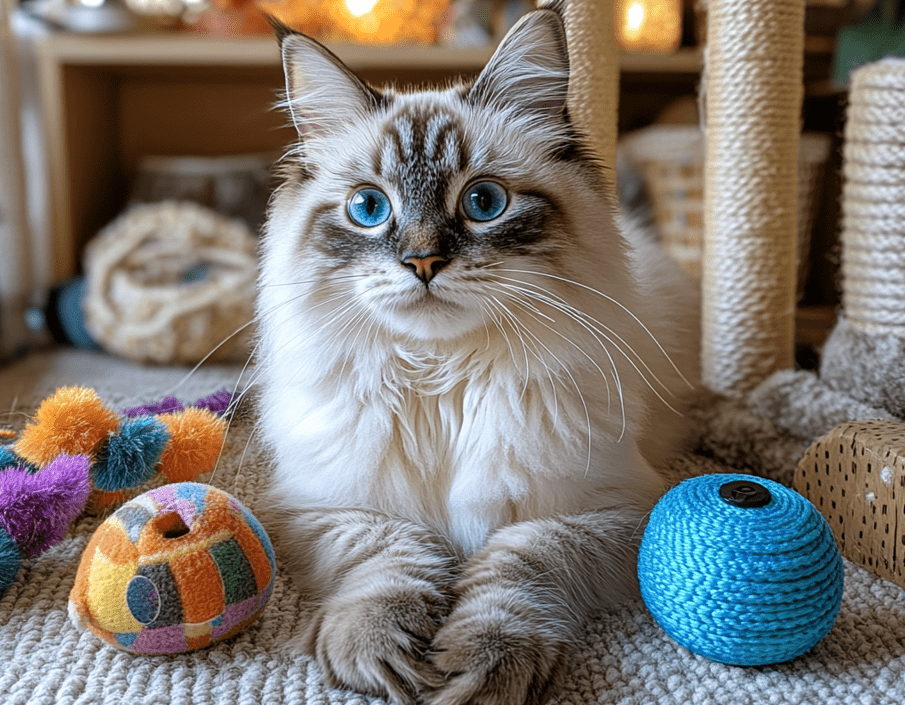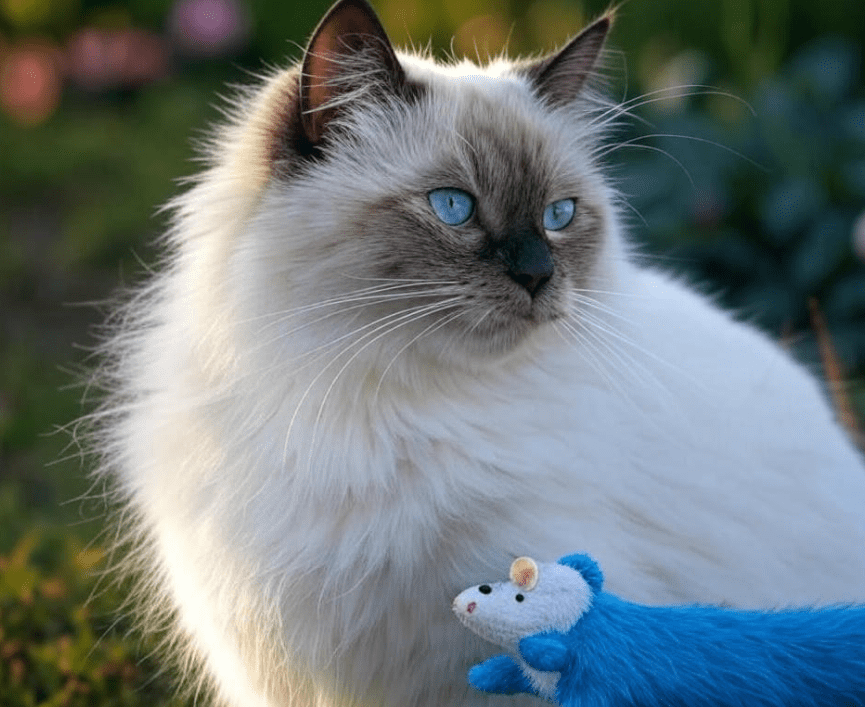
Ragdoll cats are known for their docile, affectionate nature, but even these gentle felines can find vet visits overwhelming. To make vet visits less stressful for your Ragdoll cat, preparation and understanding their unique needs are key. This comprehensive guide explores six effective strategies to ensure a smoother, calmer experience for both you and your fluffy companion. From carrier training to calming techniques, we’ll cover practical tips to reduce anxiety and make veterinary trips a breeze.
Why Vet Visits Can Be Stressful for Ragdoll Cats
Ragdolls, with their laid-back personalities, might seem like they’d handle vet visits with ease. However, several factors can trigger stress in these sensitive cats:
Unfamiliar Environments: The vet clinic’s sights, sounds, and smells can be overwhelming.
Carrier Anxiety: Many cats associate carriers with negative experiences.
Handling by Strangers: Ragdolls are often attached to their owners, so being examined by a veterinarian can feel intrusive.
Travel Discomfort: Car rides can cause motion sickness or unease.
Past Experiences: Negative memories from previous vet visits can linger.
Understanding these stressors is the first step to creating a more positive experience. By addressing each aspect thoughtfully, you can help your Ragdoll feel safe and secure.
1. Choose the Right Carrier and Train Early

The carrier is your Ragdoll’s safe haven during vet visits, so selecting the right one and making it familiar is crucial.
Selecting the Perfect Carrier
Size: Choose a carrier large enough for your Ragdoll to stand, turn, and lie down comfortably. Ragdolls are large cats, often weighing 10-20 pounds, so avoid cramped carriers.
Design: Opt for a hard-sided carrier with a top-loading option for easy access. A removable top makes it simpler for the vet to examine your cat without forcing them out.
Ventilation: Ensure the carrier has ample ventilation to keep your cat comfortable.
Comfort: Line the carrier with a soft blanket or towel that smells like home.
Carrier Training Tips
To make vet visits less stressful for your Ragdoll cat, introduce the carrier as a positive space long before the appointment:
Leave It Out: Place the carrier in a common area of your home, like the living room, with the door open. Add treats or toys inside to encourage exploration.
Positive Associations: Feed your cat near or inside the carrier to build familiarity. Gradually move the food bowl inside over a few weeks.
Practice Runs: Once your Ragdoll is comfortable, close the door for short periods while offering praise or treats. Take short car rides to mimic the vet trip, rewarding calm behavior.
Frequent Exposure: Regular interaction with the carrier prevents it from being associated solely with vet visits.
By making the carrier a safe, familiar space, your Ragdoll will feel more at ease during transport.
2. Familiarize Your Ragdoll with Car Travel
Car rides can be a significant source of stress for Ragdolls. Gradual exposure and comfort measures can make travel more tolerable.
Steps to Acclimate Your Cat to Car Rides
Start Small: Begin with short drives around the block, keeping the carrier secure on the car floor or strapped into a seat.
Create a Calm Environment: Play soft music or use a white noise app to mask unsettling sounds like traffic.
Cover the Carrier: Drape a lightweight blanket over the carrier to reduce visual stimuli, leaving enough ventilation.
Practice Regularly: Take your Ragdoll on non-vet-related car trips, like a drive to a quiet park, to dissociate car rides from stress.
Additional Tips
Avoid Feeding Before Travel: Prevent motion sickness by withholding food for 3-4 hours before the trip.
Use Familiar Scents: Place an item with your scent, like a worn T-shirt, in the carrier to provide comfort.
Secure the Carrier: Ensure the carrier doesn’t slide or tip during the drive, which can increase anxiety.
With consistent practice, your Ragdoll will become more accustomed to car travel, reducing stress on vet day.
3. Prepare for the Vet Clinic Environment
The vet clinic can feel chaotic to a Ragdoll, but you can take steps to minimize overwhelm.

Before the Visit
Choose a Cat-Friendly Vet: Look for a veterinary practice with a “Fear Free” certification or a separate waiting area for cats. These clinics prioritize low-stress handling techniques.
Schedule Strategically: Book appointments during quieter times, like early mornings, to avoid crowded waiting rooms.
Call Ahead: Inform the clinic about your Ragdoll’s temperament. Request a quiet exam room or ask if you can wait in your car until the vet is ready.
At the Clinic
Keep the Carrier Covered: A blanket over the carrier shields your cat from unfamiliar sights and smells.
Bring Comfort Items: Pack a favorite toy or blanket to provide familiarity.
Stay Calm: Cats pick up on their owner’s emotions. Speak softly and maintain a relaxed demeanor to reassure your Ragdoll.
Minimize Waiting Time: Arrive just before your appointment to reduce exposure to the waiting room.
By preparing for the clinic environment, you can help your Ragdoll feel more secure during the visit.
4. Use Calming Techniques and Products
Calming aids can significantly reduce anxiety for Ragdolls during vet visits. Always consult your veterinarian before using new products.
Natural Calming Methods
Pheromone Products: Feliway, a synthetic feline pheromone, mimics the calming scents cats produce. Use a Feliway spray in the carrier or a diffuser in your home before the visit.
Gentle Touch: If your Ragdoll enjoys petting, stroke them gently in the carrier to promote relaxation.
Calming Music: Play classical music or cat-specific relaxation tracks during the car ride and in the waiting room.
Supplements and Medications
Calming Treats: Over-the-counter treats with ingredients like L-theanine or chamomile can promote relaxation. Brands like Composure or Zylkene are popular choices.
Prescription Medications: For highly anxious Ragdolls, your vet may prescribe short-term anti-anxiety medication, like gabapentin, to be given before the visit.
CBD for Cats: Some owners use vet-approved CBD products for calming effects, but efficacy varies. Discuss this option with your vet to ensure safety.
Timing Matters
Administer calming aids or medications as directed, typically 30-60 minutes before travel, to ensure they take effect during the vet visit.
By combining natural and vet-approved calming techniques, you can help your Ragdoll stay relaxed throughout the process.
5. Practice At-Home Handling to Mimic Vet Exams
Ragdolls are generally cooperative, but unfamiliar handling during vet exams can cause stress. Desensitizing your cat to common exam procedures at home can make the real thing less intimidating.

How to Practice
Touch Their Paws: Gently handle your Ragdoll’s paws to mimic nail trims or paw inspections. Reward with treats to create positive associations.
Check Their Mouth: Lift their lips to simulate dental checks. Start with brief touches and gradually increase duration.
Examine Ears and Eyes: Use a soft cloth to gently touch their ears and around their eyes, rewarding calm behavior.
Simulate Restraint: Lightly hold your cat in a towel or blanket to mimic how a vet might restrain them. Keep sessions short and positive.
Use a Stethoscope: If possible, borrow or purchase a toy stethoscope to get your cat used to the sensation of a vet listening to their heart.
Tips for Success
Go Slow: Start with brief sessions (1-2 minutes) and gradually increase as your Ragdoll becomes comfortable.
Use Rewards: Offer treats, praise, or playtime to reinforce positive experiences.
Respect Their Limits: If your cat shows signs of stress (hissing, swatting), pause and try again later.
Regular handling practice helps your Ragdoll feel more at ease during vet exams, reducing fear of the unknown.
6. Build a Positive Post-Visit Routine
The experience doesn’t end when you leave the vet’s office. A consistent post-visit routine can reinforce positive associations and reduce future stress.
At Home
Create a Calm Space: Set up a quiet area with your Ragdoll’s favorite bed, toys, and water. Allow them to decompress without forcing interaction.
Offer Treats or Play: Reward your cat with a special treat or a play session to end the visit on a positive note.
Monitor Behavior: Watch for signs of lingering stress, like hiding or reduced appetite. Contact your vet if these persist beyond a day.
Long-Term Reinforcement
Random Carrier Time: Occasionally place your Ragdoll in the carrier for short periods at home, followed by treats, to break the vet-only association.
Positive Vet Visits: Schedule “happy visits” where your cat visits the clinic for treats and attention without an exam. This builds trust in the vet environment.
Regular Vet Checkups: Routine visits, even when your cat is healthy, normalize the experience and catch potential issues early.
A thoughtful post-visit routine helps your Ragdoll associate vet trips with positive outcomes, making future visits less daunting.
Additional Tips for Ragdoll Owners
Understand Ragdoll-Specific Needs: Ragdolls are prone to certain health issues, like hypertrophic cardiomyopathy (HCM) and urinary tract problems. Regular vet visits are essential for early detection, so reducing stress is critical for consistent care.
Work with Your Vet: Share your Ragdoll’s preferences and anxieties with the vet. A collaborative approach ensures tailored handling during exams.
Stay Consistent: Use the same carrier, blanket, and calming aids for every visit to create predictability.
Involve the Whole Family: If multiple people care for your Ragdoll, ensure everyone follows the same training and calming protocols.
Common Mistakes to Avoid
To truly make vet visits less stressful for your Ragdoll cat, steer clear of these pitfalls:
Forcing Your Cat into the Carrier: This creates negative associations. Use training to make the carrier inviting.
Skipping Preparation: Last-minute scrambling increases stress for both you and your cat.
Ignoring Stress Signs: Hissing, flattened ears, or hiding indicate anxiety. Address these promptly with calming techniques.
Rushing the Process: Allow extra time for travel and waiting to keep the experience relaxed.
Why Reducing Stress Matters for Ragdolls
Chronic stress can impact your Ragdoll’s health, leading to issues like weakened immunity, urinary problems, or behavioral changes. By taking proactive steps to make vet visits less stressful for your Ragdoll cat, you’re not only ensuring their immediate comfort but also supporting their long-term well-being. Regular, low-stress vet visits allow for early detection of health issues, which is especially important for a breed prone to genetic conditions like HCM.
Conclusion

Vet visits don’t have to be a source of dread for you or your Ragdoll cat. By choosing the right carrier, acclimating your cat to car travel, preparing for the clinic environment, using calming techniques, practicing at-home handling, and building a positive post-visit routine, you can significantly reduce stress and create a smoother experience. These six strategies empower you to make vet visits less stressful for your Ragdoll cat, fostering a healthier, happier life for your feline friend.
Start implementing these tips today, and watch your Ragdoll approach vet visits with newfound calm and confidence. With patience and consistency, you’ll transform what was once a stressful ordeal into a manageable, even positive, experience.




